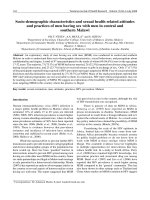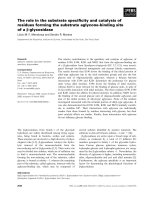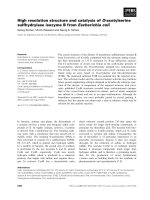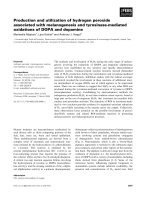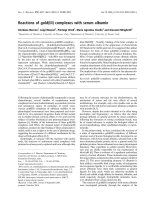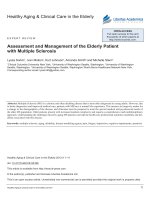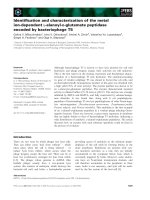Syntheses and catalysis of transition metal complexes with hemilabile ligands
Bạn đang xem bản rút gọn của tài liệu. Xem và tải ngay bản đầy đủ của tài liệu tại đây (1.06 MB, 98 trang )
Chapter 5
93
Chapter 5 – Palladium Catalyzed C-C bond Formation Involving
Organoboronic Acids.
5.1 Introduction
Great effort has been made in the development of catalytic methods for C-C bond
formations to synthesize many significant drugs, materials, optical devices etc.
126
Owing
to the low toxicity as well as high air and moisture stability, organoboronic acids have
found a broad range of applications in synthetic chemistry.
127
They are mostly used in
cross coupling reactions to form biaryl units which are common in natural products.
128
Recently, other applications in C-C bond forming processes such as 1,4-additions to
unsaturated compounds, 1,2-additions to carbonyl compounds and oxidative aminations
have also been reported.
129
The aim here is to apply the palladium precursors and the
hemilabile ligands described in chapter 2 as catalysts for the Suzuki-Miyaura cross
coupling reactions, 1,2- additions to aldehydes and 1,4-conjugate additions to α,β-
unsaturated ketones.
5.1.1 Palladium catalyzed Suzuki-Miyaura cross coupling reactions
Palladium-catalyzed Suzuki-Miyaura cross-coupling between organoboranes and organo-
electrophiles has become one of the most important C-C bond formation methodologies
(Equation 5.1).
128
It enables facile syntheses of biaryls and alkylaromatics that are
intermediates of pharmaceuticals, natural products and stereoselective reactions etc.
130
For example, tetra-ortho-substituted biaryls can be prepared from this method with the
use of bulky phosphines,
131
hybrid ligands,
132
and carbene complexes
133
(Scheme 5.1 and
5.2) etc. There are however some drawbacks, such as the cost of boron reagents, need for
high temperatures and high Pd loadings (2-12 mol%) etc. These have restricted the use of
Chapter 5
94
asymmetric Suzuki cross-coupling reactions in producing biologically active biaryls
134
and prompted the development of more efficient catalytic systems especially on ligand
innovations. Therefore, part of our research focus is to develop an efficient ligand/Pd
catalyst system for coupling sterically hindered substrates and preferably, to extend
further for asymmetric Suzuki-Miyaura cross-coupling reactions.
X B(OH)
2
R
2
R
1
R
1
R
2
+
catalyst
Equation 5.1 A typical Suzuki-Miyaura cross coupling reaction.
129
Br
B(OH)
2
+
Base,
Solvent
50-75
o
C
PR'
2
DPPF/Pd
2
(dba)
3
, 10mol% Pd used, 96 h, Product Yield = 95%
R
NMe
2
R = Me, R' = Ph, , 5 mol% Pd
2
(dba)
3.
CHCl
3
used, 72 h,
Product Yield = 85%
R = Me, R' = Ph, 3 mol% PdCl
3
used, 144 h,
Product Yield = 58%
R = Ph, R' = Ph, 5 mol% Pd
2
(dba)
3.
CHCl
3
used, 72 h,
Product Yield = 62%
R = Me, R' = 4-Ph-CF
3
, 5 mol% Pd
2
(dba)
3.
CHCl
3
used,
72 h, Product Yield = 66%
PCy
2
Ar
Pd
2
(dba)
3
Ar = Phenanthrenyl,
2 mol% Pd used, 24 h,
Product Yield = 65%
Ar
Ar
Ar
Ar
Ar
Pd
2
(dba)
3
Ar = Ph, 10 mol% Pd used,
25h, Product Yield = 25%
P(t-Bu)
2
Fe
Fe
Fe
55
133
134
Scheme 5.1. Reported Pd systems used to catalyze Suzuki – Miyaura cross couplings of
hindered Suzuki naphthalene substrates.
131a-b,132b
Chapter 5
95
PCy
2
OMeMeO
NN
O
O
X
B(OH)
2
+
base
solvent
100 - 110
o
C
12-18h
X = Br,
2 mol% Pd
2
(dba)
3
used,
Product Yield = 85%
X = Br, 3 mol% Pd(OAc)
2
used,
Product Yield = 91%
X = Cl, 3 mol% Pd(OAc)
2
used,
Product Yield = 71 - 96%
OTf
-
+
N N
Ar
iPent
Ar
Pd ClCl
X = Br,
Cat. loading = 2mol%,
Product Yield = 88%
iPent
135
136
137
Scheme 5.2. Successful palladium catalytic Suzuki-Miyaura systems reported to be
capable of producing biaryls with four ortho alkyl substituents.
132a,133
5.1.2 Palladium catalyzed 1,2- addition of organoboronic acids to aldehydes.
Chiral diaryl methanols are important intermediates for the synthesis of medically active
compounds (Figure 5.1).
135
Generally, they can be obtained either by reduction of the
corresponding unsymmetrical diaryl ketones or enantioselective aryl transfer reactions to
aldehydes (1,2-addition reactions) (Scheme 5.3).
136
However, both methods have severe
limitations and only work well for a limited range of substrates. It is accordingly pertinent
a need to develop alternative pathways that can be applied to wider variety of carbinol
derivatives.
Chapter 5
96
H
OH
X
OH
H
O
NMe
2
X = O, NSO
2
CH
3
2-Benzofuranylcarbinols
(display antifungal and
aromatic inhibiting activites)
neobenodine
(used as drugs
with antihistamine,
anticholinergic, local-anaesthetic
and laxative activties)
Figure 5.1. Some examples of diaryl methanols as intermediates for the synthesis of
medically active compounds.
135
OH
O
O
H
catalyst
[H]
catalyst
R"
2
Zn
Y
Y = organoboron, organosilane, organozinc,
organostanne, organomagnesium groups
R
R'
R
*
R R'
Scheme 5.3. General Synthetic routes to obtain biaryl methanols.
136
The 1,2-addition to aldehydes has been investigated with a variety of protocols employing
organoboron,
129c,137
organozinc,
138
organotin
139
and organosilane
140
compounds. Among
the catalytic methodologies used, the rhodium catalyzed 1,2-addition of arylboronic acids
to aldehydes is especially notable.
137a-b,f, 141
It would also be desirable to use cheaper
metals. Promising palladium catalysts such those of phosphapalladacycle,
137c
anionic
palladacycles
137i
and thioether-imidazolinium
137k
that are active towards the 1,2-addition
Chapter 5
97
reactions have accordingly emerged (Figure 5.2). On the other hand, use of palladium
complexes with hybrid ligands towards catalytic additions of arylboronic acids to
aldehydes is not known. It is therefore of our interest to investigate the efficacy of our
Pd/[P, N] ligands system towards 1,2-addition of arylboronic acids to aldehydes.
Ph
2
P
Pd
Br
Pd
PPh
2
OAc
2
N N
i-Pr
i-Pr
PhS
[Pd(allyl)Cl]
2
Fe
Cl
138
139
140
Figure 5.2. Phosphapalladacyclic complex (138), anionic palladacycle (139) and
thioether-imidazolinium chloride (140)/[Pd(allyl)Cl]
2
for the palladium catalyzed 1,2-
addition of arylborons to carbon-heteroatom double bonds.
137c,i,k
5.1.3 Palladium catalyzed 1,4- conjugate additions of organoboronic acids to
α
,
β
-
unsaturated ketones.
Some of the enantiomerically enriched compounds possessing a chiral diarylmethane unit
are known to be biologically active in antimuscarinics,
142
antidepressants,
143
and
endothelin antagonists,
144
and have received growing attention for their syntheses. One of
the straightforward methods is via conjugate addition of an aryl nucleophile to electron-
Chapter 5
98
deficient olefins substituted with another aryl groups at the
β
position. The 1,4-addition of
arylboronic acids to enones and related substrates is a versatile method reported.
137f,141c
Although the catalysts reported are dominated by rhodium-based complexes,
129c,140c,145
palladium(0)-SbCl
3
(cat A),
146
palladium-bipyridine (cat B),
147
cationic palladium(II)
complex (cat C)
137g-h
and palladacycles (cat D and E)
148,137i
have been reported as active
catalysts for 1,4-addition reactions of arylboronic acids with α,β-unsaturated ketones and
α-ketoesters (Scheme 5.4). Despite the ready availability of the reagents, the conjugate
addition of arylboronic acids to activated ketones has been elusive until now. Therefore, it
is of interest to explore the potential application of the mixed donor hybrid ligands in the
palladium-catalyzed 1,4 addition reaction of arylboronic acids to these ketones as well.
Pd
PPh
2
OAc
R R'
O
R R'
O
A
r
10mol%Pd(OAc)
2
10mol% SbCl
3
Ph
2
P PPh
2
N N
Pd
O PR
2
Cl
5mol%
[Pd(dppe)(PhCN)
2
](SbF
6
)
2
5mol%
Pd(OAc)
2
dppe =
2
5mol%
5mol%
cat A
cat B
cat C
cat D
cat E
catalyst
Catalyst:
Fe
ArB(OH)
2
Scheme 5.4. Reported active catalysts for 1,4-addition reactions of arylboronic acids with
α,β-unsaturated ketones and α-ketoesters.
137g-i, 146-148
Chapter 5
99
5.2 Results and discussion
5.2.1 Catalytic Studies
5.2.1.1
Suzuki-Miyaura cross coupling reactions of aryl halides and organoboronic acids
The ligand system (t-Bu)
2
PFcC=NCH(CH
3
)R (Fc = ferrocenyl (C
5
H
4
)
2
Fe) is chosen as a
model for this study because it contains both strong (phosphine) and weak (imine) donor
sites and that they are separated by a conformationally flexible ferrocenyl skeleton which
would in principle enable the weak donor to undergo facile reversible coordination.
8a
It is
also important that both donating sites contain a substituent group that can be changed.
This allows the introduction of substituents (R or R’) to systematically and independently
alter the electronic and steric properties of both sites.
149
Within this ligand system, there are two types (Figure 5.3). The former (ligand L1a) has
a fixed phenyl on the imine but the R on the phosphine varies, whereas the latter (ligand
L1k-o) has a variable group on the imine with a constant tBu on the phosphine. Ligand
L1a is known to support Pd-catalyzed Suzuki coupling of aryl chlorides and aryl boronic
acids
8a-b
and Ni-catalyzed ethylene oligomerization.
8c
C=N-Ph
P(t-Bu)
2
L1a
C=N
P(t-Bu)
2
R
L1k, R = Ph
L1l
, R =p-tolyl
L1m, R = p-fluorophenyl
L1n
, R = m-methoxyl
L1o, R =Naphthyl
Fe
Fe
Figure 5.3. [P, N] ferrocenyl ligand synthesized in this study.
Chapter 5
100
We first compared the catalytic ability of L1a and L1k–o towards extremely hindered
substrate combination involving 1-bromo-2-methylnaphthalene and 2-methylnaphthyl-1-
boronic acid in the presence of Pd
2
(dba)
3
under typical Suzuki cross-coupling reactions
(Table 5.1). Change of -Ph to -CH(CH
3
)(Ph) could be manifested in chelate dissociation
and halide-bridge formation, thus reducing the metal sphere congestion promoting metal-
substrate interaction. Indeed, a significant increase in the cross coupling product is
observed (Table 5.1, entry 1 and 2). It is evident that the product yields are sensitively
dependent on R (Table 5.1, entry 3 – 6). One possible explanation is the different
oxidative addition products that are formed as a result of the hemilability of the ligands.
Table 5.1: Ligand effect on the Suzuki cross-coupling reactions of 1-bromo-2-
methylnaphthalene and 2-methylnaphthyl-1-boronic acid.
a
Entry Ligand Isolated Yield
b
1
L1a
0
2
L1k
90
3
L1l
65
4
L1m
78
5
L1n
50
6
L1o
98
a
3 equiv. base.
b
Not optimized.
c
Isolated Yield is 100% if CsF is used.
Since L1o gives the highest yield in the above coupling, it is used as a model to examine
the efficiency of sp
2
-sp
2
Ar-Ar’ couplings (Table 5.2). The yields are satisfactory with
many near-quantitative conversions. Consistent with published results
128a,e-f
, sterically
B(OH)
2
Br
1.2 mol% ligand
0.5mol% Pd
2
(dba)
3
THF, Cs
2
CO
3
reflux, 24hr
+
Chapter 5
101
demanding substrates require higher catalytic loads to achieve satisfactory yields (Table
5.2, entries 6-8).Cross-coupling using sterically bulky substrates to form tetra-ortho-
substituted products were obtained in remarkably high isolated yields at low catalytic
loads of 1.0 mol% Pd (Table 2, Entries 6-8). These catalyst loadings are comparable or
lower than the reported catalyst systems.
131-132
For example, only 0.1 mol% of Pd
2
(dba)
3
(with 0.23 mol% of L1k) is sufficient to promote quantitative coupling of 1-
bromonaphthalene and naphthyl-1-boronic acid at r.t. (Table 5.2, Entry 1). This is more
favourable than the coupling of 1-bromonaphthalene and naphthyl-1-boronic acid at 1
mol% of Pd(dba)
2
and 2 mol% of 134 at r.t. over 2 days.
131b
Although electron-rich aryl
halides tend to be more sluggish in Suzuki couplings,
128
electron-rich 1-bromo-2-
methoxynaphthalene can perform better than the electron-poor 1-bromonaphthyl-2-
aldehyde in this system when sterically demanding substrates are used.
Chapter 5
102
Table 5.2. sp
2
-sp
2
Suzuki cross-coupling of aryl bromides and aryl boronic acids
catalyzed by Pd
2
(dba)
3
with ligand L1o.
a
RX + R'-B(OH)
2
Pd
2
(dba)
3
/ligand L1o
Cs
2
CO
3
, THF
R-R'
Entry
R-Br R’-B(OH)
2
mol%
Pd
Reaction
conditions
b
Isolated
% Yield
1
c
4-bromobenzaldehyde PhB(OH)
2
1x 10
-6
r.t., 2 h 100
2
c
2-bromobenzaldehyde
B(OH)
2
0.2 r.t., 6 h 100
3 2-bromobenzaldehyde
B(OH)
2
1 reflux, 12 h 100
4
Br
B(OH)
2
0.1 r.t., 6 h 100
5
Br
OMe
B(OH)
2
0.5 r.t., 12 h 100
6
Br
B(OH)
2
1 reflux, 24 h 98
7
Br
OMe
B(OH)
2
1 reflux, 12 h 84
8
Br
CHO
B(OH)
2
1 reflux, 12 h 76
a
Pd:ligand = 1:1.2.
b
Not optimized.
c
K
2
CO
3
was used instead of Cs
2
CO
3
.
Chapter 5
103
This system is also effective towards a range of aryl chlorides at low Pd loadings of 0.05–
1.0 mol%. The coupling of activated para-substituted aryl chlorides and phenylboronic
acids can be effectively carried out under ambient conditions (Table 5.3, Entry 1-7),
which is comparable to many efficient systems using bulky phosphines
131,150
and N-
heterocyclic carbenes (NHC).
133,151
The more sterically hindered substrates can also be
effectively consumed under higher temperatures and high catalytic loadings (Table 5.3,
Entry 3 – 7).
Table 5.3 sp
2
-sp
2
Suzuki cross-coupling of aryl chlorides and aryl boronic acids catalyzed
by Pd
2
(dba)
3
with ligand L1o.
a
RX + R'-B(OH)
2
Pd
2
(dba)
3
/ligand L1o
Cs
2
CO
3
, THF
R-R'
Entry R-Cl R’-B(OH)
2
mol%
Pd
Reaction
conditions
b
Isolated
% Yield
1
c
4-chlorobenzonitrile PhB(OH)
2
1 r.t., 24 h 86
2 4-chloroanisole PhB(OH)
2
0.05 50 °C, 24 h 100
3
c
3-chlorotoluene PhB(OH)
2
1 reflux, 12 h 96
4
d
4-chlorobenzonitrile
B(OH)
2
0.1 reflux, 24 h 100
5 2-chlorotoluene
B(OH)
2
1 reflux, 12 h 100
6
e
2,5-(MeO)
2
C
6
H
3
Cl PhB(OH)
2
1 reflux, 12 h 86
7
Cl
B(OH)
2
1 reflux, 24 h 97
a
Pd:ligand = 1:1.2.
b
Not optimized.
c
At 50 °C, 12 h and Pd loading = 0.01 mol%,
isolated yield = 100%.
d
1,4-dioxane was used instead of THF
Chapter 5
104
Sp
2
-sp
3
couplings using hexylboronic acid could be achieved with good yields (Table 5.4)
that are comparable with the few known systems.
150a
This subset of Suzuki cross coupling
reaction is rare. According to the survey conducted by Suzuki and Miyaura, the alkyl
boronic acids are the least reactive coupling partners (Chart 5.1).
152
This system does not
require the normal use of Tl(I) or Ag(I) bases
152
or air-sensitive trialkylboranes such as 9-
BBN derivatives,
131c
trifluoroalkylborates
153
and dialkylpinacolborates.
154
It is however
ineffective towards sp
3
-sp
3
couplings.
Table 5.4. sp
2
-sp
3
Suzuki cross-coupling of aryl halides and alkyl boronic acids catalyzed
by Pd
2
(dba)
3
with ligand L1o.
a
B(OH)
2
Ar
ArX +
L1o/Pd
2
(dba)
3
Cs
2
CO
3
, THF,
reflux
Entry
ArX mol% Pd Isolated % Yield
1 4-bromoacetophenone 0.1 100
2 2-bromobenzaldehyde 1 74
3 4-chloroacetophenone 1 100
4 3-chloroanisole 1 96
5 2-chlorotoluene 1 82
a
Pd:ligand= 1:1.2.
Boctyl
B
B
O
O
B
O
O
octyloctyl
octyl
2
octylB(OH)
2
Most Active
Least Active
Chart 5.1 Reactivity of alkyl boranes surveyed by Suzuki and Miyaura et al.
152
Chapter 5
105
5.2.1.2
1,2- and 1,4- additions of organoboronic acids to carbonyl compounds.
Initial experiments were carried out to explore the effect of additives towards our
Pd/ligand L1k system (Table 5.5). Prelimary catalytic testings showed that the Pd/ligand
L1k system catalyzed 1,2-addition of phenylboronic acid to benzaldehyde in the presence
of CHCl
3
as additive to give the corresponding alcohols at quantitative yields of 82%
(Table 5.5, Entry 2). Recently, Ito and Ohta also reported that the presence of chloroform
is essential in this type of palladium-catalyzed reaction of arylboronic acids with
aldehydes.
137d
Low product yield (20%) was obtained when an organozinc compound like
diethylzinc was added to the catalytic reaction. No conversion was observed when salts
like ZnCl
2
, InCl
3
, AlCl
3
were added. It suggested that the presence of an organo group in
the additives might be needed to trigger the addition reaction 1,2-addition of
phenylboronic acid to benzaldehyde.
Table 5.5 1,2-Addition of arylboronic acids to aldehydes catalyzed by Pd
2
(dba)
3
with
ligand L1k.
a
Ph
O
H
Ph
OH
Ph
Pd
2
(dba)
3
/ L1k
Additive
Dioxane
Cs
2
CO
3
+ Ph-B(OH)
2
Entry
Additive
b
Conversion (%)
c
1 0 0
2 CHCl
3
82
3 ZnCl
2
0
4 ZnEt
2
20
5 InCl
3
0
6 AlCl
3
0
a
The reaction was carried out with benzaldehyde (1.0 mmol), phenylboronic acid (2.0
mmol), Cs
2
CO
3
(1.0 mmol), Pd
2
(dba)
3
(1.0 mol%) and ligand L1k (2.2 mol%) in 2mL of
1,4-dioxane, at 70 ºC, 16 h.
b
1.0 mmol of additive is added.
c
Based on GC Yield.
Chapter 5
106
Among the metal precursors tested, only Pd
2
(dba)
3
and [Rh(COD)Cl]
2
could show
satisfactory yields (82% and 98% respectively, Table 5.6, entries 3 and 11). Use of Pd(II)
compounds such as PdX
2
(X = Cl, OAc) or Pd (COD)Cl
2
are less effective (4-39%, Table
5.6, entries 4 – 7). Other d
10
compounds (such as CuX (X = Cl, I) and Ni(COD)
2
are
largely inactive. The reported active rhodium and palladium catalysts reported are
invariably supported by diphosphines (dppf, dppp, dppe)
137f
and monodentate phosphines
[e.g. PPh
3
137d
and P(1-Nap)
3
(1-Nap = 1-Naphthyl)]
116e
respectively. The activity shown
by a potentially hemilabile ligand such as L1k suggests that it is more compatible with
the metals as it could perform dual function, viz. monodentate and chelating.
Table 5.6: Effect of metal precursor towards 1,2 –addition of phenylboronic acid to
benzaldehyde.
a
Entry Metal Precursor %Yield
1 NiCl
2
20
2 Ni(COD)
2
8
3 Pd
2
(dba)
3
82
4 Pd(OAc)
2
31
5 PdCl
2
4
6 Pd(COD)Cl
2
39
7 Pt(COD)Cl
2
31
8 CuCl 0
9 CuI 0
10 FeCl
2
0
11 [Rh(COD)Cl]
2
98
a
Reaction conditions (not optimized): benzaldehyde (1.0 equiv), phenylboronic acid (2.0
equiv), L1k (1.0 mol%), metal precursor loading (1.0 mol%), Cs
2
CO
3
(2.0 equiv), CHCl
3
(0.1 mL) 1,4-dioxane (2 mL), 70°C, 16 h.
b
Isolated Yields (average of 2 runs).
Chapter 5
107
Further catalytic investigations were then performed using the palladium solvent adduct,
Pd
2
(dba)
3
·CHCl
3
as the palladium(0) source instead. This reaction is strongly solvent
dependent, showing good yields for 1,4-dioxane and CHCl
3
(98% and 82% respectively,
Table 5.7, entries 1 and 6) but negligible for the likes of PhMe, MeOH and MeCN. The
carbonates of K
+
or Cs
+
are the best supporting bases (89% and 98% respectively, Table
5.8, entry 1-2). Increasing the L1k:Pd ratio from 1.2 to 2 would also suppress the product
yield from 98% to 64%.
Table 5.7: Solvent effect towards 1,2-addition of phenylboronic acid to benzaldehyde.
a
O
H
B(OH)
2
OH
+
Pd
2
(dba)
3.
CHCl
3
L1k
solvent
Cs
2
CO
3
, 70
o
C
Entry Solvent %Yield
b
1 1,4-dioxane 98
2 Toluene 0
3 MeOH 0
4 THF 50
5 MeCN 0
6 CHCl
3
82
a
Reaction conditions (not optimized): benzaldehyde(1.0 equiv), phenylboronic acid (2.0
equiv), L1k (1.0 mol%), Pd loading (1.0 mol%), Cs
2
CO
3
(2.0 equiv), solvent (2 mL),
70°C, 16 h.
b
Isolated Yields (average of 2 runs).
Chapter 5
108
Table 5.8: Effect of base towards 1,2-addition of phenylboronic acid to benzaldehyde.
a
O
H
B(OH)
2
OH
+
Pd
2
(dba)
3.
CHCl
3
L1k
1,4-dioxane
base, 70
o
C
Entry Base %Yield
b
1 Cs
2
CO
3
98
2 K
2
CO
3
89
3 KF 38
4 K
3
PO
4
0
5 KOH 0
6 Et
3
N 8
7 NaOH 0
a
Reaction conditions (not optimized): benzaldehyde (1.0 equiv), phenylboronic acid (2.0
equiv), L1k (1.2 mol%), base (2.0 equiv), Pd loading (1.0 mol%), 1,4-dioxane (2 mL), 70
°C, 16 h.
b
Isolated Yields (average of 2 runs).
Based on the conditions optimized above, a list of ligands at 1 mol% was screened
towards the 1,2-addition of phenylboronic acid to benzaldehyde (Chart 5.2). The ligands
cover monophosphines[(C
5
H
5
)Fe(C
5
H
4
PPh
2
)], diphosphines (dppf, dppp, dppb) and a
range of monophosphine with a secondary donor of varying strengths (Chart 5.2).
Chapter 5
109
Chart 5.2 Ligand screening towards Pd-catalyzed 1,2-addition of phenyl boronic acid to
benzaldehyde.
a
O
H
B(OH)
2
O
H
+
Ligand
Pd
2
dba
3
.CHCl
3
1,4-dioxane
Cs
2
CO
3
, 70
o
C
overnight
Ligand:
PR
2
N
PR
2
N
PR
2
N
PPh
2
PPh
2
PPh
2
PCy
2
R
O
O
PPh
2
N
Ph
PPh
2
N
R'
PPh
2
N
H
R'
R = Cy,
L1d:
Product Yield = 85%
= Ph, L1f: Product Yield = 89%
=
t
Bu,
L1k:
Product Yield = 98%
R = Cy, L1e: Product Yield = 23%
= Ph,
L1j:
Product Yield = 56%
=
t
Bu, L1o: Product Yield = 90%
R = Ph,
L1a:
Product Yield
=
86%
R = tBu,
L1c:
Product Yield
=
50%
DPPF
Product Yield = 13%
141
Product Yield = 68%
R = H, L2a: Product Yield = 47%
R = Ph,
L2b
: Product Yield = 50%
R' = Ph, 59: Product Yield = 0%
R' = Ph, L3a: Product Yield = 0%
R' = Nap, L3b: Product Yield = 0%
dppp
Product Yield = 9%
63, Product Yield = 0%
O
O
PPh
2 dppb
Product Yield = 23%
13
, Product Yield = 50%
Fe Fe
Fe
Fe Fe
Fe
Fe
Ph
2
P PPh
2
Ph
2
P
PPh
2
a
Reaction conditions (not optimized): ketone (1.0 equiv), arylboronic acid (2.0 equiv),
Ligand (1%), Cs
2
CO
3
(2.0 equiv), 1,4-dioxane (2 mL), 70°C, 16 h. (average of 2 runs).
Chapter 5
110
From Chart 5.2, the hemilabile iminophosphine ligands (L1a, L1c-f, L1j, L1k & L1o)
generally show the highest activities, surpassing the diphosphines (9-23%). This is in
agreement with literature results which also reported mediocre yields for diphosphines
(e.g. dppp, dppb, Yields: <52%)
137d-e
, monodentate phosphines/Pd and the palladacycles
which require at least 5mol% of Pd loadings to achieve satisfactory yields (73 –
98%).
137d-e,i
The yields are dependent on the substituents on both donors. Bulky
phosphine substituents tend to perform the best. The aminophosphine 59, in stark contrast
to the iminophosphine counterpart, is effectively inactive. This could be attributed to the
much stronger sp
3
amine as a donor, thus giving a chelate as stable as that of a
diphosphine. The donor strength is not the only parameter that influences the catalytic
efficacy. Even the ligand skeleton has a strong effect on the yields. This is exemplified
when replacement of the ferrocenyl skeleton (in L1f & L1j) by an aryl (in L3) would
inactivate the system. This reflects the advantage offered by a skeletally flexible
framework which could support the engagement and disengagement of the second donor.
The ability for the ferrocenyl iminophosphine to switch facilely between the monodentate
and chelating coordination modes is hence believed to be a key parameter that influences
the catalytic efficiency. This is further evident in 13 & L2 when the yields are mediocre
(47 – 50%) as the basicity of the second donor is weakened to the extent that the ligand
resembles more a monodentate than a hemilabile chelating system.
The catalytic addition is effective towards a range of aldehydes (Table 5.9), giving
excellent yields (92 – 100%) except when electron-rich aldehydes or arylboronic acids
were involved (33 – 68%) are used. A slower transmetallation in these arylboronic acids
makes the system more prone to homocoupling and protodeboronation side reactions.
155
Chapter 5
111
Table 5.9 1,2-Addition of arylboronic acids to aldehydes catalyzed by Pd
2
(dba)
3
·CHCl
3
and ligand L1k.
a
R
O
H
R
OH
R'
Pd
2
(dba)
3
.CHCl
3
L1k
1,4-Dioxane,Cs
2
CO
3
+ R'-B(OH)
2
Entry
Aldehyde R’B(OH)
2
% Yield
1 Benzaldehyde PhB(OH)
2
100
2 4-methylbenzaldehyde PhB(OH)
2
95
3 4-fluorobenzaldehyde PhB(OH)
2
98
4 3-cyanobenzaldehyde PhB(OH)
2
97
5 4-methoxybenzaldehyde PhB(OH)
2
33
b
6 3-tolylbenzaldehyde PhB(OH)
2
92
7 2-tolylbenzaldehyde PhB(OH)
2
98
8 Benzaldehyde 2,6-(Me)
2
C
6
H
3
B(OH)
2
66
9 4-methylbenzaldehyde 4-(MeO)C
6
H
4
B(OH)
2
68
a
The reaction was carried out with aldehyde (1.0 mmol), arylboronic acid (2.0 mmol), Cs
2
CO
3
(1.0 mmol), Pd
2
(dba)
3
·CHCl
3
(0.5 mol%) and ligand L1k (1.0 mol%) in 2 mL of 1,4-dioxane, at
70 ºC, 16 h.
b
96% when 2.5 mol% Pd
2
(dba)
3
·CHCl
3
was used.
For comparisons, the activities of these hybrid ligands towards the 1,4-addition of
arylboronic acids to α,
β
-unsaturated ketones, represented by trans-chalcone (1,3-
diphenyl-2-propen-1-one), under similar reaction conditions have also been examined
(Table 5.10). Similar to the 1,2-addition described above, the tBu-substituted
iminophosphine L1k is also the best performer. Electron-rich or sterically hindered
arylboronic acids are also less effective (Yield: 43 – 78%, Table 5.10, entries 5 -7). Other
α,
β
-unsaturated ketones examined (such as 2-cyclohexenone, benzylideneacetone, 5-
methyl-3-hexen-2-one…) are inactive.
Chapter 5
112
Table 5.10 1,4-Addition of Arylboronic Acids to trans-chalcone catalyzed by
Pd
2
(dba)
3
·CHCl
3
with selected mixed hybrid donor ligand.
a
O
Ph
Pd
2
(dba)
3
.CHCl
3
Ligand
1,4-Dioxane,Cs
2
CO
3
+ R'-B(OH)
2
Ph
O
PhPh
R'
Entry
Ligand R’B(OH)
2
% Yield
1
L1k
PhB(OH)
2
100
2
L2b
PhB(OH)
2
24
3
L3a
PhB(OH)
2
67
4
13
PhB(OH)
2
85
5
L1k
2,6-(Me)
2
C
6
H
3
B(OH)
2
65
6
L1k
4-(MeO)C
6
H
4
B(OH)
2
78
7
L1k
NapB(OH)
2
43
a
The reaction was carried out with trans-chalcone (1.0 mmol), arylboronic acid (2.0 mmol),
Cs
2
CO
3
(1.0 mmol), Pd
2
(dba)
3
·CHCl
3
(0.5 mol%) and ligand (2.2 mol%) in 2 mL of 1,4-dioxane,
at 70 ºC, 16 h.
5.2.2 Coordination studies of potential catalytic active palladium [P, N] intermediate
formed between [P, N] ferrocenyl ligands and Pd(0) precursors
5.2.2.1 [P, N] palladium complexes formed oxidative addition in Suzuki-Miyaura cross-
coupling reaction
Extensive synthetic and mechanistic studies have been carried out over the past
decades.
128
The commonly accepted mechanism of Palladium catalyzed Suzuki –
Miyaura cross coupling reaction involves an initial oxidation addition of the aryl halide to
a palladium (0) species, followed by transfer of the aryl group from the boronic acid to
the palladium(II) centre (transmetallation) and eventually by the reductive elimination to
give the biaryl product and regenerate the catalytically active palladium(0) species
Chapter 5
113
(Scheme 5.5).
128
However, when hindered substrates were involved, the process was
complicated by protonolysis or deboronation.
155
Therefore, fast reductive elimination to
compete with hydrolysis and deboronation was the key to the success of the reaction. A
more comprehensive mechanism had been proposed by Cammidge et al (Scheme 5.6).
144c
Observations that hindered aryl iodides gave faster and better reactions during the cross
coupling of hindered aryl halides and boronic acids suggest that reductive elimination
might be triggered by oxidative addition step in the mechanism.
155
Pd(0)L
2
ArX
Ar-Pd(II)L
2
-X
Ar'-Pd(II)L
2
-Ar
Ar-Ar'
ArB(OH)
2
B(OH)
2
X
-
Oxidative addition
Reductive elimination
T
r
a
n
s
m
e
t
a
l
l
a
t
i
o
n
Scheme 5.5 A general mechanism for Suzuki-Miyaura cross coupling reaction.
128
Chapter 5
114
Pd(0)L
2
L
Pd
L
Ar
X
L
Pd
X
Ar
L
L
Pd
L
Ar
Ar'
L
Pd
Ar
Ar'
L
Ar'-B(OH)
2
Nu
A
r
'
-
H
Deboronation
Ar'B(OH)
2
Base
slow
(disfavored if
Ar and Ar' is bulky)
Disproportionation,
leading to homocoupling
or hydrolysis
By-products
Ar-Ar'
HX
A
r
-
B
r
X-B(OH)
2
Nu
n-
Oxidative
Addition
Transmetallation
Reductive
Elimination
Scheme 5.6 A mechanism proposed for the Suzuki-Miyaura cross coupling reaction of
hindered coupling partners.
144c
Oxidative addition is a key step in Suzuki couplings.
156
Ample studies have been
conducted on the aryl and alkenyl electrophiles with Pd(0) involving hindered
monophosphine/bisphosphine [such as P(Cy)
3
, dppf, BINAP] ligands.
128c,150b,157
However,
there are no clear trends applicable to oxidative addition of palladium species with mixed
hybrid ligands.
8a
Thus, to gain some ideas on the contribution of the steric bulk on the
imine substituent of the [P, N] ligands towards the Pd intermediate in the Suzuki cross
coupling reaction, we carried on to examine the relationship between the ligand structure
L1o with Pd
2
dba
3
and aryl halides, ArX such as pentafluoroiodobenzene, 1-
iodonaphthalene or 1-bromonaphthalene (Scheme 5.7).
Chapter 5
115
N
P
Pd
Ph
Ph
O
L1o
+ Pd
2
(dba)
3
C11
N
P
Pd
I
R
C12a: R = C
6
F
5
C12b
: R = Nap
P
Pd
I
I
R
Pd
R
P
P
P
Pd
Br
Nap
Br
P
Pd
Nap
P
+
NapBr
NapBr
C=N
P(t-Bu)
2
Nap
=
Where:
C13a: R = C
6
F
5
C13b:
R = Nap
C14
For
C12a
, prolong stirring
For C12b, heat
N
N
ArI
R-I
N
N
N
N
N
P
Fe
L1o
Scheme 5.7.
Reaction of ligand
L1o
and Pd
2
(dba)
3
with aryl
halides.
Reaction of
L1o
with Pd
2
(dba)
3
in situ to give proposed intermediate {η-
C
5
H
4
CH=N[CH
3
(CH)C
10
H
7
]}Fe[η-C
5
H
4
P(t-Bu)
2
]Pd(dba),
C11
, which undergoes
oxidative addition with pentafluoroiodobenzene or 1-iodonaphthalene to give the d
8
Pd(II)
complex {η-C
5
H
4
CH=N[CH
3
(CH)C
10
H
7
]}Fe[η-C
5
H
4
P(t-Bu)
2
]Pd(I)(R)
, C12a–b
with aryl
trans to imine nitrogen.
8b
Complex
C12a
(ESI m/z 811; δP 75.2 ppm) is thermally
unstable, which is exemplified for its decomposition to
C11
(major, ESI m/z 633.2; δP
56.2 ppm) when subject to heating in THF at 60°C for 1 h (Figure 5.4) in the presence of
dba. The ability of dba to keep the metal (in form of
C11
) in solution is apparent.
158
Upon
prolonged stirring in the absence of dba,
C12a
converts to {{η-
C
5
H
4
CH=N[CH
3
(CH)C
10
H
7
]}Fe[η-C
5
H
4
P(t-Bu)
2
]Pd(I)(C
6
F
5
)}
2
,
C13a
(major species, δP
86.7 ppm) instead. However, unlike
C12a
, complex
C12b
converts to {{η-
Chapter 5
116
C
5
H
4
CH=N[CH
3
(CH)C
10
H
7
]}Fe[η-C
5
H
4
P(t-Bu)
2
]Pd(I)(C
10
H
7
)}
2
C13b
(major) when
heated at 60°C for 24 h. The formation of
C13
from
C12
highlights the ability for the
hemilabile iminophosphine to adapt to dimerization.
Figure 5.4.
The
31
P-{
1
H} NMR spectra of complex {{η-C
5
H
4
CH=N[CH
3
(CH)C
10
H
7
]}
Fe[η-C
5
H
4
P(t-Bu)
2
]Pd(I)(C
6
F
5
)}
2
,
C13a
at room temperature (a) and the decomposition
of complex {{η-C
5
H
4
CH=N[CH
3
(CH)C
10
H
7
]}Fe[η-C
5
H
4
P(t-Bu)
2
]Pd(I)(C
6
F
5
)}
2
,
C13a
at
60°C (b) in the presence of dba.
Reaction of 1-bromonaphthalene with
L1o
/Pd
2
(dba)
3
or
C11
gives a mononuclear Pd(II)
species, {{η-C
5
H
4
CH=N[CH
3
(CH)C
10
H
7
]}Fe[η-C
5
H
4
P(t-Bu)
2
]}
2
Pd(Br)(C
10
H
7
),
C14
,
with two iminophosphine ligands with dangling imines (Scheme 5.7). The contrast
between
C14
and
C13
suggests that the oxidative addition product is dependent on the
5101520253035404550556065707580859095
5101520253035404550556065707580859095
(ppm)
File 1
:
C:\WIN1D\SPC\ASPX32\SH0827~1\004001.1R
File 2
:
C:\WIN1D\SPC\ASPX32\SH0924~1\011001.1R
(a)
(b)
Chapter 5
117
aryl halide, as reported.
46b,156b
NMR analysis of
C14
suggests that it exists as a mixture of
cis- (δP = 60.74) and trans- (δP = 60.01) isomers. The
31
P NMR resonances of
C14
broadened at 60°C (Figure 5.5). Complex
C14
decomposes to Pd black and
L1o
under
elevated temperatures.
51015202530354045505560657075
51015202530354045505560657075
51015202530354045505560657075
(ppm)
Figure 5.5.
The variable temperature
31
P-{
1
H} NMR study of {{η-
C
5
H
4
CH=N[CH
3
(CH)C
10
H
7
]}Fe[η-C
5
H
4
P(t-Bu)
2
]}
2
Pd(Br)(C
10
H
7
),
C14
, at room
temperature (a), 60 °C (b) and back to room temperature (c).
(a)
(b)
(c)
